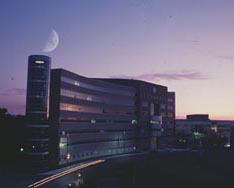History of the Program of Computer Graphics
|
|
Prior to 1973, much of the research in computer graphics at Cornell
was conducted at a GE research facility in Syracuse.
Donald Greenberg and students of his would travel to Syracuse
to arrive as the normal workday ended,
and leave when the machines were needed again the following morning.
The Program of Computer Graphics received its first
National Science Foundation grant in the fall of 1973,
which enabled Dr. Greenberg to order the first computer graphics equipment.
That equipment arrived early in January of 1974,
and the first lab was set up in Rand Hall on the Cornell Campus.
|

Rhodes Hall at night
(photo by Cornell News Service)
In 1991, the Program of Computer Graphics moved to
the new Engineering and Theory Center Building across campus,
now renamed Rhodes Hall as a tribute to Dr. Frank H.T. Rhodes,
the former president of Cornell.
Also in 1991, Cornell became one of five universities
participating in the new National Science Foundation
Science and Technology Center
for Computer Graphics and Scientific Visualization.
This long-term research center was established by Don Greenberg
with four distinguished academic colleagues,
and he served as the director of the Center
from its inception through July of 1995.
The original mission of the NSF Center,
to rebuild the foundations of computer graphics,
has become even more important in the nine years
since the Center was established.
In addition, the center has served as
an experimental collaboratory among the five universities,
linked by full-time video, audio and data connections
used for teaching, adminstration, and research.
Our close ties to graphics labs at Brown University,
the University of North Carolina at Chapel Hill, the University of Utah,
and Caltech have influenced our research and broadened the exposure
our graduate and undergraduate students received here at Cornell.
As a central participant in the new
Faculty of Computing and Information Science, the Program of Computer Graphics
is actively engaged in interdisciplinary teaching and research across
the University. The graduate students based in our lab are pursuing degrees in the
fields of Architecture, Computer Science,
and Mechanical and Aerospace Engineering, and our Director holds a joint
appointment in Computer Science, Architecture, and the Johnson Graduate School of Management.
At the undergraduate
level our portfolio of courses includes Interactive Computer Graphics
in the Computer Science Department
and an innovative Architectural Design Studio. Our ties to the field of architecture
go back to the beginning of the lab,
and we still find architectural modeling to be
one of the most challenging computer graphics applications.